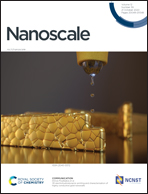Sensitively switchable visible/infrared multispectral detection and imaging based on a tandem perovskite device†
Abstract
Multispectral detection and imaging facilitate advances in target identification; for example, the switchable functionality of sensing visible photons and sensing near-infrared photons in the eyes of some vertebrate species provide visual sensitivity beyond the range of human vision. In this work, a single sensor device is constructed with stacking solution-processed MAPbI3 and MA0.5FA0.5Pb0.5Sn0.5I3 in opposite polarity for the multispectral detection of visible and NIR photons. With applied bias modulating built-in potential, the sensing response is tunable, while the good ambipolar carrier transport and high trap tolerance in perovskite films ensure high performance. As a result, the selective sensing toward visible photons from 350–800 nm and NIR photons from 700–1000 nm is achieved in a single photodetector under −0.3V and 0.5 V, respectively, with a high on/off ratio of ∼104, a relatively low optical crosstalk of −70 dB, and specific detectivity of over 1012 Jones. Moreover, the high mode-switching rate of 1000 Hz in altering the visible and NIR sensing mode and the high −3 dB bandwidth of ∼50 kHz enable our solution-processed perovskite-based multispectral photodetector to be recognized as an advanced technique for the fast and sensitive target multispectral imaging and identification.



 Please wait while we load your content...
Please wait while we load your content...